Colombia in Korea
I. Background
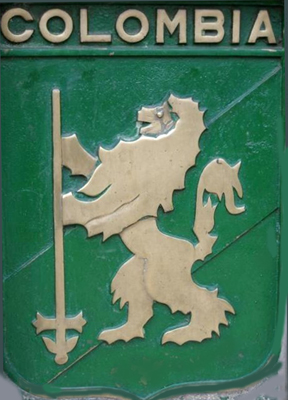
Columbia was the only Latin American country to serve during the Korean Conflict. It was the first time in 127 years that Colombian forces engaged in foreign military operations.
Colombian Army
The 1st Battalion was the first Colombian army unit to serve during the Korean Conflict. It arrived in Korea during June 1951. It was initially assigned to the US 24th Infantry Division and subsequently to the US 7th Infantry Division. Each successive Colombian battalion also served as part of the US 7th Infantry Division. The 1st Battalion was replaced during July 1952 by the 2nd Battalion. The 3rd Battalion arrived in November 1952 and was replaced by the 4th Battalion during June 1953. Each battalion had an approximate peak strength of 1,070 men.
Although it fought valiantly, the 3rd Battalion was severely mauled during the fifth battle (March 23-26, 1953) on Old Baldy (Hill 268 in west central Korea) during March 1953 when it was overrun by a numerically superior Chinese 117th Division. The Battle of Old Baldy actually refers to a series of engagements, which were spaced over a ten month period. Colombian forces fought extremely well. The Battalion suffered 95 killed-in-action, 30 missing-in-action and 97 wounded. There were many examples of individual heroism among the Colombian forces. It was estimated that the Chinese forces suffered 750 losses.
Korea was Colombia's only foreign war (excluding peacekeeping missions). A total of 4,314 Colombian soldiers served in Korea. In total, Colombia lost 146 killed, 448 wounded, 69 missing in action during the course of the war. During the campaign, Colombian servicemen were awarded: (1) two US Legion of Merit medals; (2) 18 Silver Stars; (3) 25 Bronze Stars with V (valor) device and (4) nine Bronze Stars.
Colombian Armada
The Columbian Navy utilized three previous US ships during the Korean Conflict. Approximately 1,000 sailors saw service during the Conflict. The ships and their deployment dates were: (1)the Almirante Padilla from May 1951 to January 1952 and March 1955 to October 1955; (2) the Capitan Tono from February 1952 to January 1953 and April 1954 to March 1955 and (3) the Almirante Brion from June 1953 to April 1954.

ARC Almirante Padilla FG-11 formerly the USCGC Groton PF-29
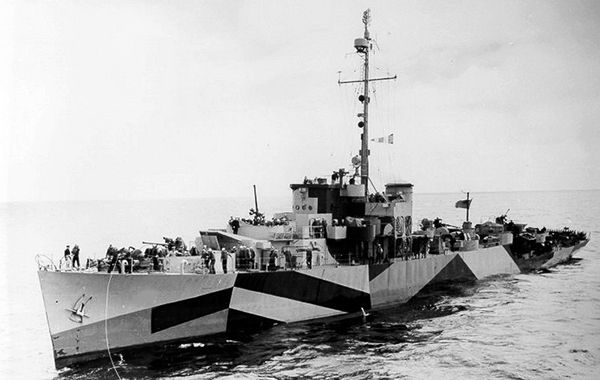
ARC Capitan Tono formerly USCGC Bisbee PF-46
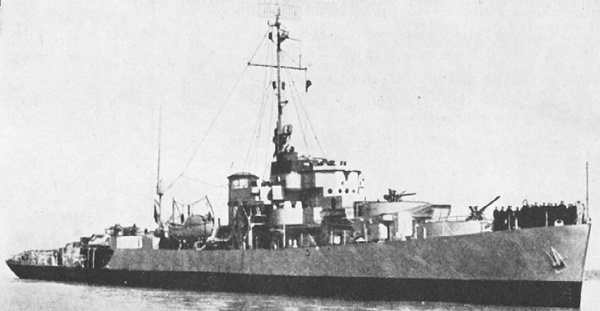
ARC Almirante Brion F-14 formerly USS Burlington PF-51
II. Medals Associated with the Colombian Forces in the Korean Conflict
Korean Campaign Medal
The obverse of the extremely rare circular bronze medal features the Seal of the Colombian Republic and the curved inscriptions, REPUBLICA DE COLOMBIA above and FUERZAS MILITARES below. The reverse features the Taeguk (the Korean symbol for the ultimate reality from which all things and values originate) with the curved inscription, CAMPANA DE COREA below.
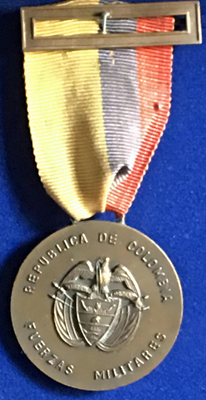

Colombian Veteran’s Ribbon Bar
Colombian Infantry Battalion Medal (Medal of Honor for Mission Accomplished)
The obverse features a soldier holding the Colombian flag atop a mountain. The flag is enameled yellow - red - blue (top to bottom) and a curved wreath is visible along the lower rim of the planchet. The reverse features the rampant lion sleeve insignia of the battalion with the curved inscription. BATTALION DE INFANTERIA “COLOMBIA” above and on a raised tablet below, the two line inscription, HONOR / AL DEBER COMPLIDO (Mission Accomplished). A few extremely rare examples (estimated at 50) were produced in Japan and reflect design variances, including the absence of the wreath at the base of the obverse.
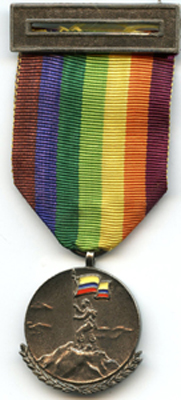
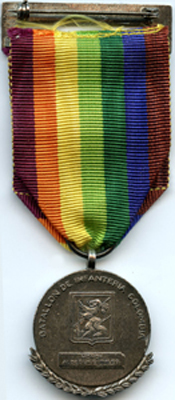
Colombian Infantry Battalion Medal in Silver
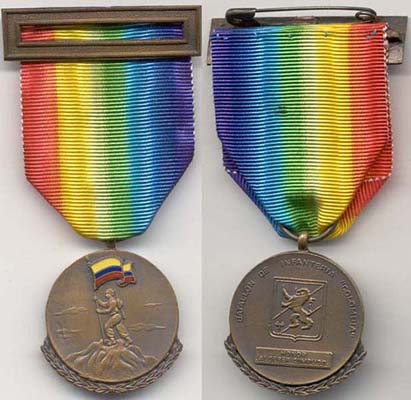
Colombian Infantry Battalion Medal in Bronze
Medal for Distinguished Service in International War
This medal, consisting of two distinct planchets, was created in 1952 by decree number 812, and awarded in two categories to military personnel for acts of bravery or meritorious acts during war or international conflict overseas.
Cruz de Hierro
The first, the Cruz de Hierro (Iron Cross), is in the form of a darkened iron Padua cross with inset and beaded rim, which resembles the German Iron Cross. It can be awarded with a laurel device (palm) for distinguished valor; or without for merit or devotion to duty in action.
Estrella de Bronce
The second, the Estrella de Bronce (Bronze Star), is a faceted bronze five-pointed star, which resembles the US Bronze Star.
The obverse of each medal is embossed with the Colombian coat of arms in the center (within a circular laurel wreath for the Bronze Star). The reverse bears an appropriate campaign symbol and the name of the operation or conflict (e.g. Korean Taeguk and CAMPANA DE COREA) with the addition of ACCION DISTINGUIDA DE VALOR for the Iron Cross. The medals are suspended by a ring from an identical distinctive ribbon. To date, the medal (in both formats) has only been authorized for the Korean Conflict. Additional awards are indicated by a bronze oak leaf mounted to the ribbon.
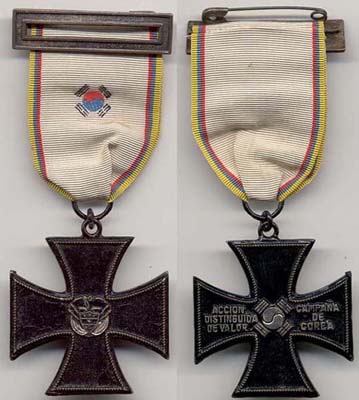
Cruz de Hierro
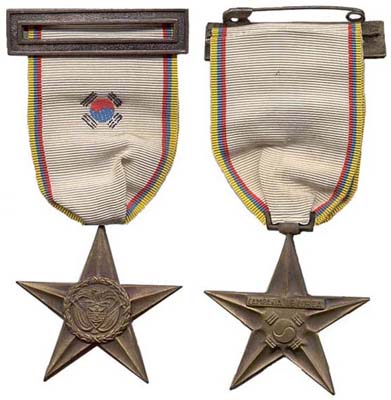
Estrella de Bronce
Combat Wound Badge
The 45mm x 15mm gilt framed badge is in the shape of an elongated oval with red enamel background. A 3/16" bronze star is added for each wound.

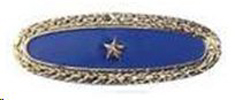
Combat Infantry Badge for International Conflict
This badge is very similar to the wound badge but it is slightly less elongated and the wreath is open at the top. The center depicts antique crossed muskets from the period of Colombia’s struggle for independence from Spain circa 1819.
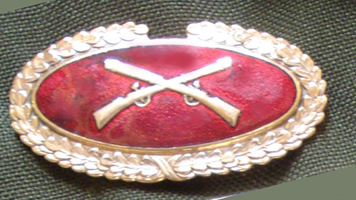
Colombian Army Uniform Patches
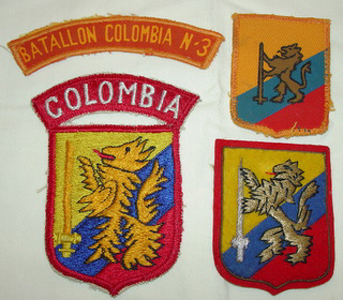
1st Battalion Flag
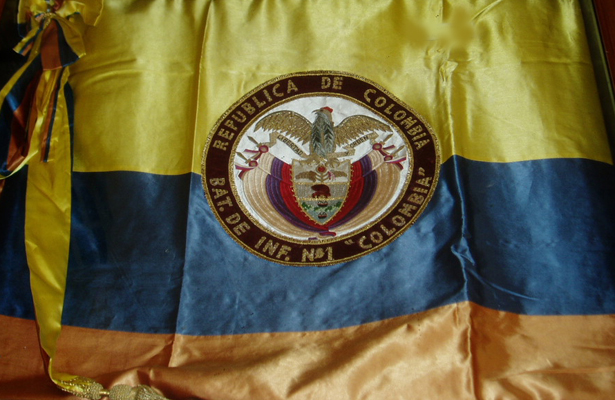
Official and Unofficial UN Korean Medals
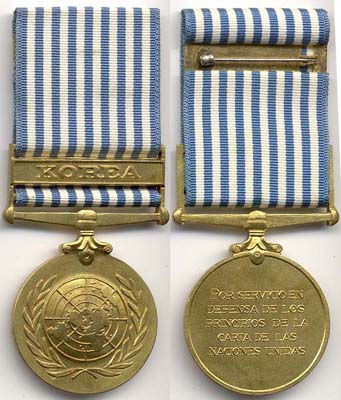
The Official Spanish Version Sometimes Referred to as the Type 2
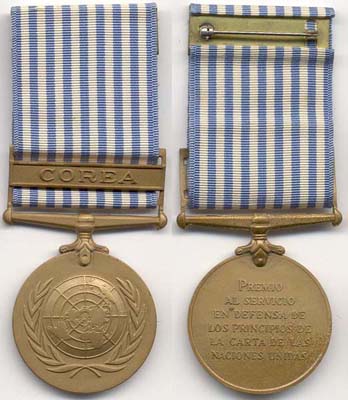
Unofficial Spanish Version with Bar COREA Often Referred to as the Type 1 Spanish Version
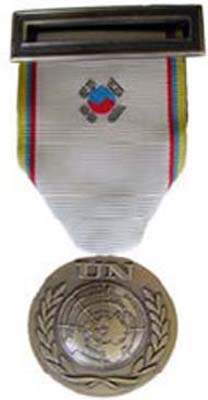
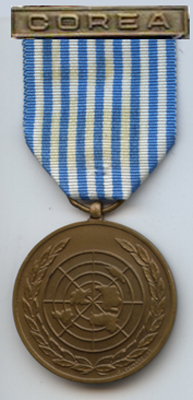
Unofficial Version with Ribbon from the Medal for Distinguished Service in International War and Unofficial Version without Straight Suspender, with Top Bar COREA, Flattish Globe and Two-Line Curved Reverse Inscription in Spanish
Korean Presidential Unit Citation Ribbon
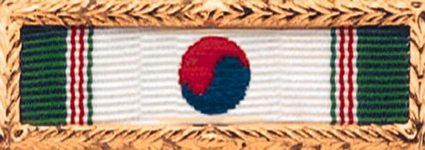
The gold bordered ribbon is awarded by the government of the Republic of Korea to members of meritorious units.
Korean War Service Medal
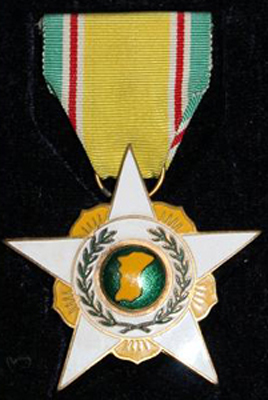
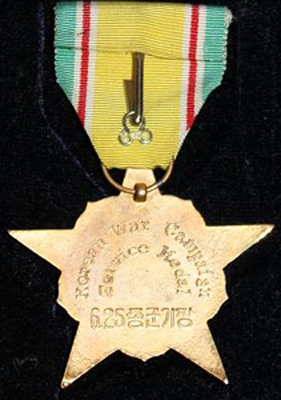
Type 1 South Korean Incident Participation Medal 1950-53
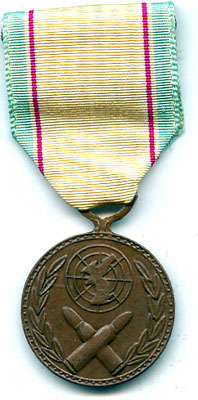
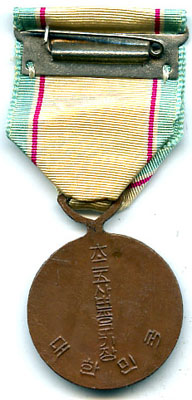
Original Type 2 South Korean War Service Medal 1953
The Korean War Service Medal or Republic of Korea War Service Medal was first
authorized in December 1950. Originally known as the Incident Participation Medal the medal
was first awarded to South Korean troops who had participated in the initial counter-assaults
against North Korean aggression in June 1950.
In 1951, the Incident Participation Medal was renamed as the War Service Medal and further authorized for any troops who were defending South Korea against invasion. In 1954, the South Korean government authorized the Type 2 version of the medal to all UN troops who had fought in the Korean War between the dates of June 25, 1950 to July 27, 1953.
The obverse of the bronze medallion depicts a Mercator's projection of the earth with an outline of the Korean peninsula. At the bottom-center, there are two cartridges crossed saltire. From the base of the cartridges on either side, a laurel wreath extends upwards and terminates at the edge of the globe. The entire central theme is surrounded by a double-edged circular border following the contour of the medal, and between the lines of the border it is charged with dots.
The original reverse of the medal produced in Korea contains Korean characters which identify the purpose of the medal. The reverse of the version currently available from the United States bears the two-line inscription FOR SERVICE / IN KOREA above two raised tablets, the upper tablet being slightly longer than the lower.
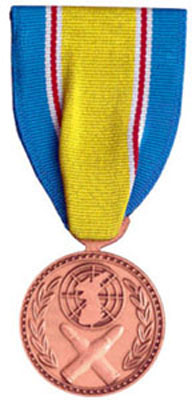
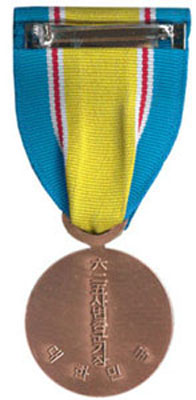
Current Late 90’s Strike
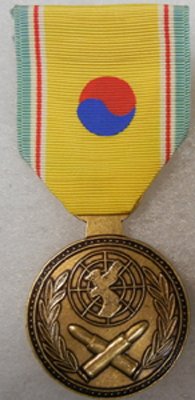
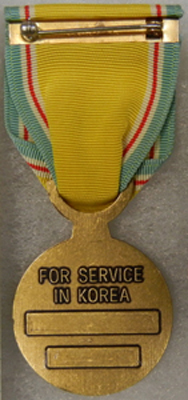
US Made Obverse and Reverse
III. Colombian Army Veteran Images
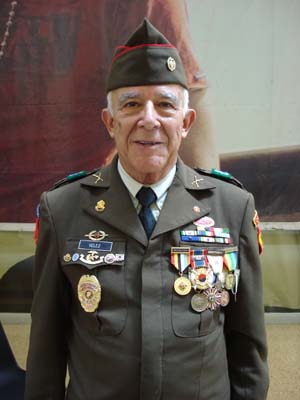
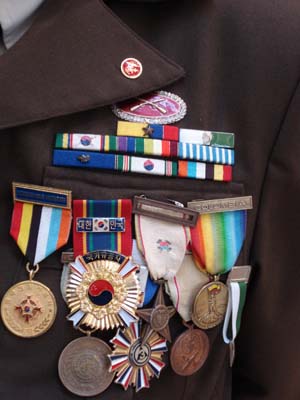
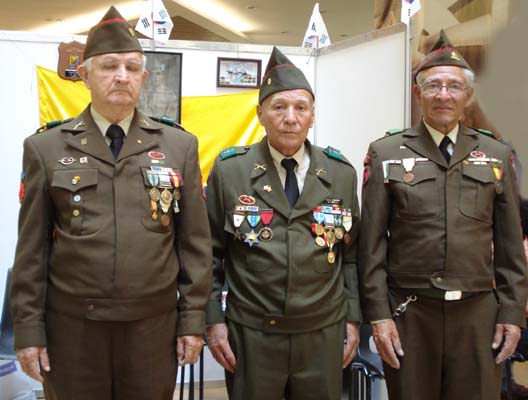
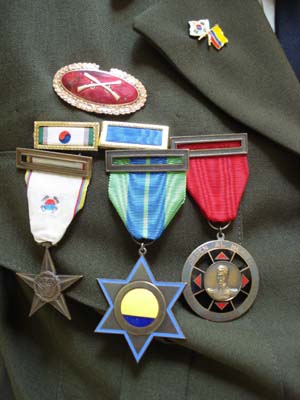
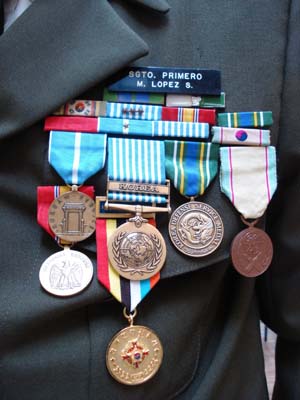
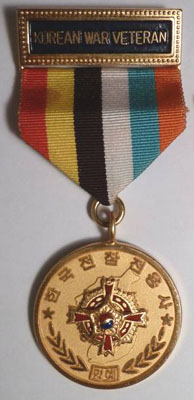
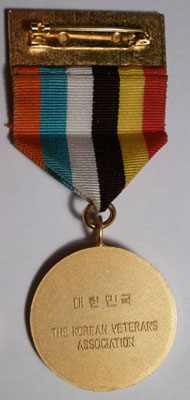
Korean Veterans Association Ambassador for Peace Medal
The gilt commemorative Ambassador for Peace Medal from the Seoul Korean War Veterans
Association, was presented to members who participated in the revisit program. The Ambassador
of Peace Medal was also presented to deserving veterans, who were unable to revisit Korea for
medical reasons. The association issued each medal with a certificate of thanks inscribed,
"Everlasting gratitude of the Republic of Korea for the service you and your countrymen have
performed in restoring and preserving our freedom and democracy. We cherish in our hearts the
memory of your boundless sacrifices in helping us re-establish our Free Nation."
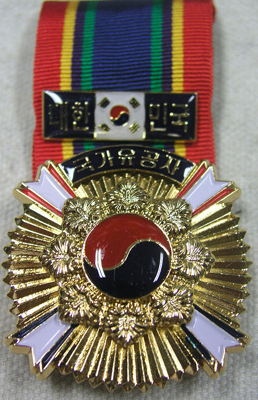
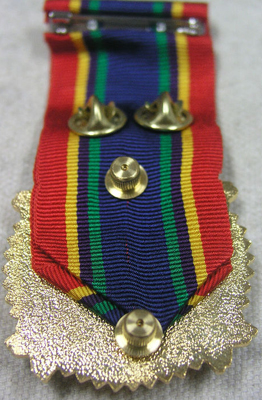
Korean Veterans Association Individual Merit Medal
The medal’s central design is the country’s coat-of-arms. The country’s local name, Daehan
Minguk is inscribed in Korean above. The Taeguk (central design) originates from the old
oriental philosophy called the theory of Um-Yang, in Chinese Yin-Yang. Yin means dark and
cold, while Yang means bright and hot. The idea of Yin-Yang originates from the old Korean
philosophy of Samshin meaning three gods. A very old book called Chuyok or I-ching in Chinese,
written several thousand years ago, claims all objects and events in the world are expressed by
the movement of yin and yang. The national flag forms the central design on the bar above.
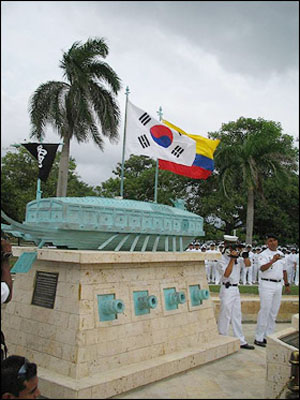
Korean War Memorial Cartegna, Colombia
The memorial features a miniature model of the Geobukseon, an ironclad turtle-shaped warship that
fended off Japanese invaders during the late 16th century, which will be permanently exhibited in
Colombia. The monument commemorates Colombia’s participation in the Korean War was and is displayed
in the port city of Cartagena.
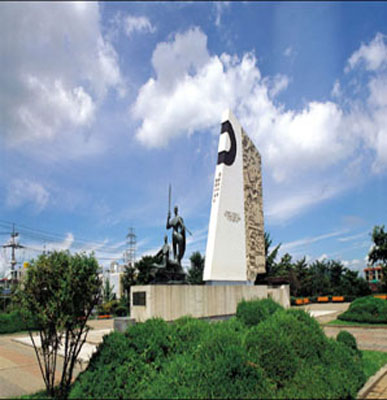
Memorial to Colombian Veterans, Inchon, Korea
This Monument was established to commemorate the everlasting friendship with Colombia which supported
the ROK forces in the Korean War by dispatching one infantry Battalion and one frigate, as well as to
respect Colombian soldiers who were killed during the war.
Special thanks to Esteban Rivera for the generous use of his images.
IV. Links
Battle of Old Baldy: http://en.wikipedia.org/wiki/Battle_of_Old_Baldy#The_Colombian_Battalion
Colombian Battalion in Korea (in Spanish): http://foro.unffmm.com/viewtopic.php?f=40&t=323
Korean War the Colombian Battalion: http://www.caballerosandantes.net/index.php?cid=21&page=17
I. Background

Columbia was the only Latin American country to serve during the Korean Conflict. It was the first time in 127 years that Colombian forces engaged in foreign military operations.
Colombian Army
The 1st Battalion was the first Colombian army unit to serve during the Korean Conflict. It arrived in Korea during June 1951. It was initially assigned to the US 24th Infantry Division and subsequently to the US 7th Infantry Division. Each successive Colombian battalion also served as part of the US 7th Infantry Division. The 1st Battalion was replaced during July 1952 by the 2nd Battalion. The 3rd Battalion arrived in November 1952 and was replaced by the 4th Battalion during June 1953. Each battalion had an approximate peak strength of 1,070 men.
Although it fought valiantly, the 3rd Battalion was severely mauled during the fifth battle (March 23-26, 1953) on Old Baldy (Hill 268 in west central Korea) during March 1953 when it was overrun by a numerically superior Chinese 117th Division. The Battle of Old Baldy actually refers to a series of engagements, which were spaced over a ten month period. Colombian forces fought extremely well. The Battalion suffered 95 killed-in-action, 30 missing-in-action and 97 wounded. There were many examples of individual heroism among the Colombian forces. It was estimated that the Chinese forces suffered 750 losses.
Korea was Colombia's only foreign war (excluding peacekeeping missions). A total of 4,314 Colombian soldiers served in Korea. In total, Colombia lost 146 killed, 448 wounded, 69 missing in action during the course of the war. During the campaign, Colombian servicemen were awarded: (1) two US Legion of Merit medals; (2) 18 Silver Stars; (3) 25 Bronze Stars with V (valor) device and (4) nine Bronze Stars.
Colombian Armada
The Columbian Navy utilized three previous US ships during the Korean Conflict. Approximately 1,000 sailors saw service during the Conflict. The ships and their deployment dates were: (1)the Almirante Padilla from May 1951 to January 1952 and March 1955 to October 1955; (2) the Capitan Tono from February 1952 to January 1953 and April 1954 to March 1955 and (3) the Almirante Brion from June 1953 to April 1954.

ARC Almirante Padilla FG-11 formerly the USCGC Groton PF-29

ARC Capitan Tono formerly USCGC Bisbee PF-46

ARC Almirante Brion F-14 formerly USS Burlington PF-51
Korean Campaign Medal
The obverse of the extremely rare circular bronze medal features the Seal of the Colombian Republic and the curved inscriptions, REPUBLICA DE COLOMBIA above and FUERZAS MILITARES below. The reverse features the Taeguk (the Korean symbol for the ultimate reality from which all things and values originate) with the curved inscription, CAMPANA DE COREA below.


Colombian Veteran’s Ribbon Bar
The obverse features a soldier holding the Colombian flag atop a mountain. The flag is enameled yellow - red - blue (top to bottom) and a curved wreath is visible along the lower rim of the planchet. The reverse features the rampant lion sleeve insignia of the battalion with the curved inscription. BATTALION DE INFANTERIA “COLOMBIA” above and on a raised tablet below, the two line inscription, HONOR / AL DEBER COMPLIDO (Mission Accomplished). A few extremely rare examples (estimated at 50) were produced in Japan and reflect design variances, including the absence of the wreath at the base of the obverse.


Colombian Infantry Battalion Medal in Silver

Colombian Infantry Battalion Medal in Bronze
This medal, consisting of two distinct planchets, was created in 1952 by decree number 812, and awarded in two categories to military personnel for acts of bravery or meritorious acts during war or international conflict overseas.
Cruz de Hierro
The first, the Cruz de Hierro (Iron Cross), is in the form of a darkened iron Padua cross with inset and beaded rim, which resembles the German Iron Cross. It can be awarded with a laurel device (palm) for distinguished valor; or without for merit or devotion to duty in action.
Estrella de Bronce
The second, the Estrella de Bronce (Bronze Star), is a faceted bronze five-pointed star, which resembles the US Bronze Star.
The obverse of each medal is embossed with the Colombian coat of arms in the center (within a circular laurel wreath for the Bronze Star). The reverse bears an appropriate campaign symbol and the name of the operation or conflict (e.g. Korean Taeguk and CAMPANA DE COREA) with the addition of ACCION DISTINGUIDA DE VALOR for the Iron Cross. The medals are suspended by a ring from an identical distinctive ribbon. To date, the medal (in both formats) has only been authorized for the Korean Conflict. Additional awards are indicated by a bronze oak leaf mounted to the ribbon.

Cruz de Hierro

Estrella de Bronce
The 45mm x 15mm gilt framed badge is in the shape of an elongated oval with red enamel background. A 3/16" bronze star is added for each wound.


Combat Infantry Badge for International Conflict
This badge is very similar to the wound badge but it is slightly less elongated and the wreath is open at the top. The center depicts antique crossed muskets from the period of Colombia’s struggle for independence from Spain circa 1819.

Colombian Army Uniform Patches

1st Battalion Flag

Official and Unofficial UN Korean Medals

The Official Spanish Version Sometimes Referred to as the Type 2

Unofficial Spanish Version with Bar COREA Often Referred to as the Type 1 Spanish Version


Unofficial Version with Ribbon from the Medal for Distinguished Service in International War and Unofficial Version without Straight Suspender, with Top Bar COREA, Flattish Globe and Two-Line Curved Reverse Inscription in Spanish

The gold bordered ribbon is awarded by the government of the Republic of Korea to members of meritorious units.
Korean War Service Medal


Type 1 South Korean Incident Participation Medal 1950-53


Original Type 2 South Korean War Service Medal 1953
In 1951, the Incident Participation Medal was renamed as the War Service Medal and further authorized for any troops who were defending South Korea against invasion. In 1954, the South Korean government authorized the Type 2 version of the medal to all UN troops who had fought in the Korean War between the dates of June 25, 1950 to July 27, 1953.
The obverse of the bronze medallion depicts a Mercator's projection of the earth with an outline of the Korean peninsula. At the bottom-center, there are two cartridges crossed saltire. From the base of the cartridges on either side, a laurel wreath extends upwards and terminates at the edge of the globe. The entire central theme is surrounded by a double-edged circular border following the contour of the medal, and between the lines of the border it is charged with dots.
The original reverse of the medal produced in Korea contains Korean characters which identify the purpose of the medal. The reverse of the version currently available from the United States bears the two-line inscription FOR SERVICE / IN KOREA above two raised tablets, the upper tablet being slightly longer than the lower.


Current Late 90’s Strike


US Made Obverse and Reverse







Korean Veterans Association Ambassador for Peace Medal


Korean Veterans Association Individual Merit Medal

Korean War Memorial Cartegna, Colombia

Memorial to Colombian Veterans, Inchon, Korea
Special thanks to Esteban Rivera for the generous use of his images.
IV. Links
Battle of Old Baldy: http://en.wikipedia.org/wiki/Battle_of_Old_Baldy#The_Colombian_Battalion
Colombian Battalion in Korea (in Spanish): http://foro.unffmm.com/viewtopic.php?f=40&t=323
Korean War the Colombian Battalion: http://www.caballerosandantes.net/index.php?cid=21&page=17
Website Maintained by Vaudezilla